Head Covering: The Modeling of Divine Order
In 1 Corinthians 11, we find a very controversial passage of scripture. The matter of covering and uncovering the head while praying or prophesying is fundamentally a very simple practice, yet one that involves some very profound spiritual truths!

Few, today, give head covering much thought. In some churches across Europe, you'll still find women covering their heads while most have abandoned it. There are exceptions, mostly in the scattered communities of Amish, Hutterites, Mennonites, Mormons, Brethren, some Catholics, etc.
In the Western culture, there are still some remnants of the influence of biblical tradition. If you're a male, you're reminded to remove your hat for the National Anthem and display of the national flag. It's a patriotic act meant to show respect. Men might also remove their hats during a church service, and when they're seated at the table for a formal meal, which had often been prefaced with prayer, the "saying of grace." We have a nod to tradition when a bride wears a veil as she's being wed. It's a sign of modesty and innocence and a metaphor as she veils herself prior to the signaling of their union. These nods to tradition are shadows of the practices of the saints of days gone by. Later in this study, I'll give more attention to the history of the practice.
The passage of our special interest instructs us about divine order and how men and women may bear witness to it. It's not at all a matter of the legalistic bondage of religious requirement, and neither is it, as some suppose, a matter of cultural tradition. It's about bearing the responsibility to model the truth of God's order to all creation, and it's a way of entering into great blessing, power, and freedom in Christ.
Here's the featured passage, I Corinthians 11:1-17, from the NASB 95 version.
Before launching into the study, I'd like to share some very relevant personal history.
My Personal Testimony
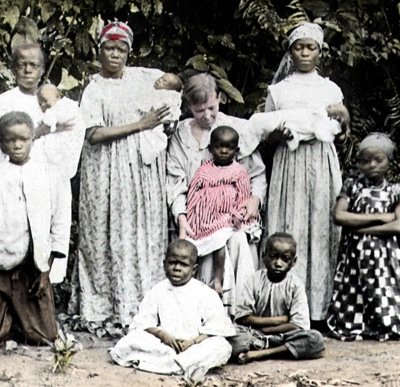
Some time ago, I was prompted by the spirit of the Lord to ask why the relationships between men and women were such a mess, particularly within the church. What I received was that men and women in the church have rebelled against the Lord by disobeying the commands governing their gender roles. Myself included! One example concerns head covering. You, too, may have been deceived regarding this practice by those you have trusted to teach and model proper God-fearing behavior. May the Lord, in His kindness, mercy, and grace, grant us eyes to see and the wisdom and courage to obey. Glory to God!
I discovered that head covering was personally relevant when I was praying in my office one day, perhaps around 1997. A relative had recently given me a beautiful tallit. She had purchased this traditional prayer shawl during a trip to Jerusalem and I was honored to receive it as a gift. Jewish men typically wear a tallit on their heads while praying, and you will find men in Messianic congregations wearing them as well. While I was praying in my office on that memorable day, I unwrapped the tallit and placed it over my head. What I had expected to find was a more intimate and powerful experience but what I found instead was that I was immediately very uncomfortable, disturbed even. While I didn't understand the reason for my reaction, I took it off and never put it over my head again. Before long, the Lord gave me some insight into the reason why I had that experience. I had dismissed head covering as not applicable and unimportant - but it really does matter to Him!
The reason why the passage in 1 Corinthians 11 is controversial today is because the simplicity of the truth has been targeted by some to undermine the message and rob the saints of their faith, power and reward. I believe the third chapter of 2 Peter has something to say to us today.
Do you believe the holy spirit's message that was given through the Apostle Peter about the Apostle Paul's writings in all his letters? I do. Yet, we should acknowledge the fact that it's not always the untaught and unstable who are responsible for distorting the things of which he spoke. Sometimes it's the educated, the intellectual, and scholarly. Among them are the well-respected in the church, who are reverenced and held in high esteem, like how it was with the false prophets of old. The arguments meant to lead us astray can seem quite plausible and compelling and these are often pitched to us with drama and passion. If we challenge what we may have learned and had modeled to us, giving what Paul wrote in the controversial eleventh chapter of 1 Corinthians our full attention, his messages will be seen to be both clear and unambiguously stamped with the authority of the Author Himself!
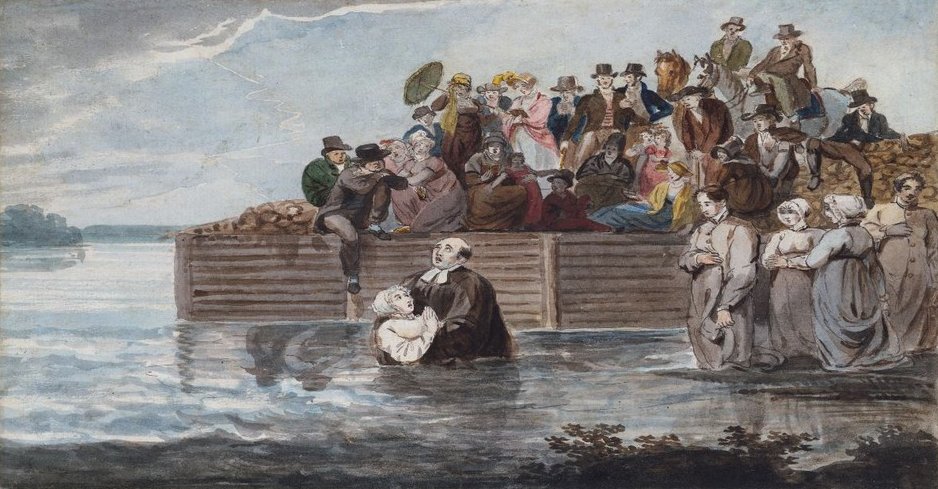
Is a Woman's Hair "the Covering"?
When the featured passage in 1 Corinthians 11 is read, the question often arises as to whether the woman's hair might be THE covering that is sufficient. This notion may have arisen from ambiguous translations like the one found in the NASB 95.
While "for a covering" seems to suggest that her hair might be sufficient, the source Greek text is more correctly rendered as, "instead of a covering." Consider these more literal versions.
- "Instead of a covering" (Young's Literal Translation, Literal Standard Version, Berean Literal Bible)
- "As a substitute for coverings" (International Standard Version)
- "In place of a covering" (Aramaic Bible in Plain English, GOD'S WORD® Translation)
Since her hair is given to her instead of a covering, it's therefore NOT a covering, at least not THE covering of note. When we see a woman with hair on her head, especially when it's long hair, we can see that it covers her head. Yet, her hair is given to her instead of a covering. While it's difficult to grasp whatever deeper meaning might be implied, it's easy enough to conclude with certainty that her hair is not the kind of covering that compares to that with which a man may cover or uncover his head.
Let's explore other verses and continue to use our critical thinking skills.
If "a woman does not cover her head" and hair is presumed to be the covering then this woman's head is not covered with hair. When we then read, "let her also have her hair cut off," you have to wonder how you could cut off hair she doesn't have? Logically and obviously, if hair is her covering, the direction given is nonsensical! Clearly, the woman's head is to be covered while praying or prophesying with something other than or supplemental to her hair.
If her hair is THE covering, does it make sense that the command to cover applies only to two very specific activities? For her to cover her head with hair when she's either praying or prophesying, well, is she expected to have a wig or hairpiece at the ready? Hair on - hair off - hair on - hair off. It only makes sense for her to use a hat, scarf, shawl or similar kind of accessory to cover or optionally uncover her head to suit the requirement of the moment. Compare this to the direction given for men who must uncover the head when praying or prophesying. Is there any question that his covering isn't about his hair, whether long, short or bald?
It should by now be apparent that the prescribed covering isn't a woman's hair, but to be a little more thorough let's consider the wider use of the word used in verse 15 for "covering."
The words, "to her for a covering" are, peribolaiou, in the Greek text. The exact form of the word is found only here, but in the Greek language, other forms don't alter the meaning of the word except to indicate how it fits within the sentence. Another form is found in Hebrews.
Think about what will happen to the heavens and how the Lord will roll them up like - hair? No! Like a mantle, a fabric covering!
Forms of the word are found three times in two verses in the book of Ezekiel. This is, of course, in the Septuagint (LXX), the Greek version of the Old Testament.
In conclusion of this matter, when she prays or prophesies, the woman is to cover her head with a fabric covering.
Culturally Relevant?
Can we reject the passage of interest as one that applied only to a different culture or season of the age? Let's give this some consideration, starting with the context of this particular epistle or letter: To whom was it addressed?
So, the letter was written most specifically to "the church of God that is in Corinth, to those sanctified in Christ Jesus, called to be saints." But he went on to address it more inclusively, "together with all those who in every place call upon the name of our Lord Jesus Christ, both their Lord and ours." This includes the saints of every geographic location, which also implies the full range of cultural and religious traditions. It can be argued that this implies a universal application throughout the age. And, I will soon make that very argument!
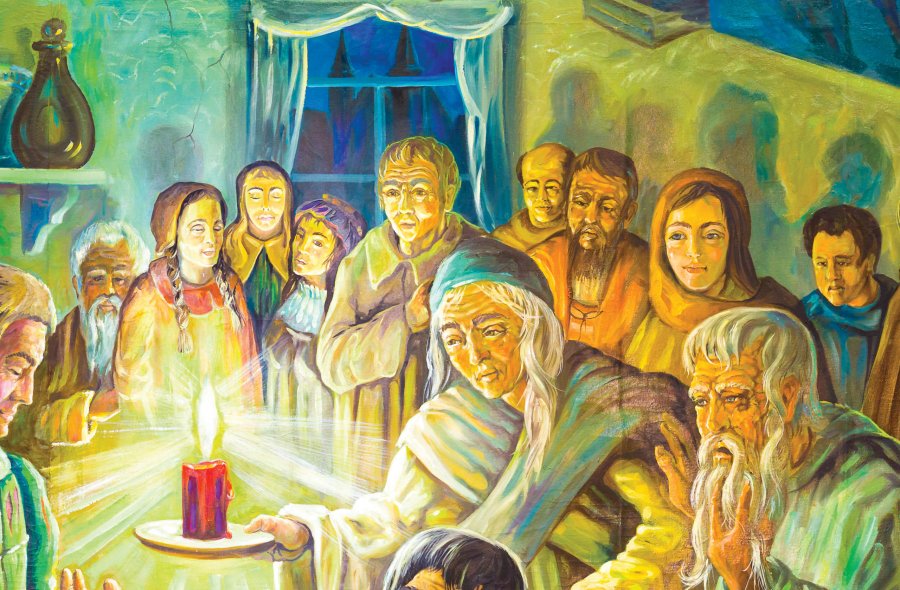
When we get to the eleventh chapter of this same book, an informative statement is made in the very context of the revelation about covering the head. There must already have been some contention that Paul was required to address.
Without variance, what Paul set forth concerning head covering and hair length was already the universally accepted standard of practice throughout the church. This established fact carries some weight of authority because it was expected to settle the matter of contention.
Now, to make a point about the applicability of the commands concerning head covering in this present season, make note that the point made in verses 8 and 9 clearly references creation itself.
Here's the foundational text.
If the creation account is still relevant, and it certainly is, it stands to reason that the natural order and the commands given in 1 Corinthians 11 are entirely relevant and applicable throughout the age.
Could the passage of interest be dismissed as a message that depends upon the culture or a limited season of the age for its applicability? If it could be, the same flawed argument could be made to justify the dismissal of any and every message of the Bible.
The Glory Language
You may want to pause for a moment to reread the passage of interest, to become better acquainted with the details.
The practice of covering and uncovering the head involves authority and its modeling. This modeling of authority can be understood in terms of what I refer to as the glory language. It explains a lot about the directions given for both head covering and hair length!
We read about glory in verses 7 ("since he is the image and glory of God") and 15 ("if she have long hair, a glory it is to her" [YLT]), where we find it in the context of the covering of the head and the length of hair. The usage of the word, glory, in verse 15 compares it by way of contrast to the word, dishonor, used in verse 14. According to Thayer, the Greek word used for glory (doxa) literally means, "what evokes good opinion, i.e. that something has inherent, intrinsic worth." Glory can also be understood as the exhibit of, or, display of, manifesting power. To understand the glory language we must have a firm grasp of the context of the situation being governed.
What it is that makes praying and prophesying special apart from any other activity? It's then that we are in communication with and in communion with our God. There's a spiritual connection. It matters not at all whether we're praying in tongues or with our understanding, or whether we're in a public or a private setting. It's in our engaging of the heavenly realm in the presence of God that covering the head becomes important.
An angel or angels may be involved in this special situation, who are in His presence. An illustration is found in Revelation 8.
When we engage the heavenly realm through praying or prophesying, we effectively enter into the presence of the Holy and Sovereign God, a situation that, very appropriately, demands our respect.
Here's an essential passage for the understanding of head covering, hair length, and the glory language, from the first chapter of the book.
(To the carnal mind, the practice of head covering is a foolish and a weak thing.) From this passage we learn "that no flesh should glory in His presence." And, "as it is written, He that glorieth, let him glory in the Lord." This glorying is boasting, in some versions. What bearing does this have upon head covering? Consider how the subject of the order or rank of authority is central to head covering, being addressed in the third verse of this 11th chapter.
When we pray or prophesy, we enter into the presence of the highest ranking authority there is! It's there that "no flesh should glory."
A man or woman, by praying or prophesying, while yet being clothed upon with the natural body of flesh, enters His presence in the realm of the spirit. This entrance is not merely in some figurative or symbolic sense but truly in reality. This is a spiritual truth.
Here's an account of what happened to a man who expressed an understanding of headship and authority.
There are, native to this temporal body, aspects of glory. I Corinthians 11:7 informs us that the man is the image and glory of God, while verse 15 informs us that the woman is the glory of man, and her hair is a glory to her. A manifestation of the image and glory of God in His presence causes no offense. In contrast, a manifestation of the glory of man, which the woman is, or a manifestation of that which is a glory to the woman (her long hair) brings an offense as flesh glorying or boasting in His presence. This is foundational to the glory language.
Although the act of covering or uncovering the head is an observable action that takes place in the natural realm, it truly extends into the spiritual realm. Jesus and His Father bear witness to the act as do the angels; both those who minister on our behalf and those who do not. These witnesses have an intrinsic comprehension of authority and rank because it strictly governs their order. (Think about how earthly armies are organized, with 5 star generals, 4 star and so on, with ranks like captains and sergeants and privates of first, second, and third class ranks.) Those who dwell in the unseen realm observe the praying saints and the glory language in every instance speaks to them in their native language, in a sense. For those of us in this earthly realm, when we observe the same, do we understand? Can we interpret the glory language?
Consider how head covering might appear when looking down from above, like how Jacob saw the Lord in a dream (Genesis 28), high up, standing above the ladder spanning heaven and earth. When a man's head is uncovered, since he is the image and glory of God (v 7), that's what's exposed and manifesting. Conversely, when a man's head is covered, the image and glory of God is hidden. When a woman's head is uncovered, since she is the glory of man, that's what manifests. Since her hair is also uncovered and her hair is a glory to her, her own personal "hair-glory" is also manifesting. Conversely, when a woman's head is covered, both the glory of man and that which is a glory to her is hidden.

This chart illustrates the glory language, showing how it is across the spectrum of head covering. Regarding the man and woman together, there are four possible combinations: 1. both uncovered, 2. both covered, 3. man only covered, and 4. woman only covered. See the big picture. There's only one model that bears witness to Divine Order. Through simple obedience to the Lord's commands while praying and prophesying, the testimony brought forth for all to witness is an expression of the image and glory of God! The saints enter into God's presence with humility and respect, with no flesh glorying or boasting in His presence!
You may find yourself wondering about those situations where a man or a woman are praying independently, unmarried and unattached. How then is the glory language adequately expressed? I've prayed and reflected on this and I'll share my thoughts, which you might find interesting, if not insightful. You might think I'm really getting into the weeds here but I know I'm going to be asked this question so I'm being thorough and proactive by addressing it here.
In the case of an unattached man who's not praying with a woman, if his head is uncovered, the glory language is the same as if a covered woman was praying with him. In the unattached woman's case, while properly covering her head, it appears like there's no "image and glory of God" component because there's no male present. (I'll elaborate on this in a moment.) What makes sense to me is that we have to consider the larger scope of the prayers of the saints. Men and women are praying, somewhere, whether together in a local congregation or video chat, as a couple or family, or independently in "isolation." In the big picture, all the saints who are praying and communing with God have the Mind of Christ. In Christ, we are His body. He is the head, and there is unity. We are living stones in the Temple of God. We're not really independent or alone because we all share a connection.
I previously wrote, "it appears like there's no "image and glory of God" component because there's no male present." I'd like to elaborate on that. I have a sense that a woman's covering (I'll call it a scarf for the sake of clarity.) is associated with her head - and I don't mean the obvious appendage she covers with the scarf. What I mean is that the "authority on her head" that equates to her scarf (as addressed in the upcoming section titled, A Symbol of Authority on Her Head - Because of the Angels) might reference her higher ranking member in the headship hierarchy. The scarf is then functioning as a kind of proxy for the male "image and glory of God" component, and sometimes Christ Himself! For many, this is their understanding of the scarf, that it is a sign of their submission to male authority.
When a woman is married, her husband is her head, most directly. Until such a time when she marries, best case scenario - her earthly father (or otherwise a grandfather, uncle or brother) is the head to whom she is subject. So, yeah, what if your father was Bruce Jenner and he starts to identify as a she? What then??? Eh, yeah - let's not get carried away with this, but you should see where I'm going with this scarf-proxy-headship attribution. It's reasonable to ask about a woman who never marries, about widows and, certainly, in the real world, divorced women. In lieu of a believing man who agrees to take on the responsibility as her head, her head is Christ, skipping up to the next rung of the ladder, so to speak.
That's my take on it. Thanks for asking. :)
What has been presented thus far should help settle some of the most fundamental questions about head covering. Some of your remaining questions probably arise from the more peripheral issues. These shouldn't distract us from the simplicity of the commands but, realistically, they tend to do just that . This is the Enemy's purpose, and the Adversary has been very effective in his assault on the saints!
Two Kinds of Heads
We'll ease into these more peripheral (yet not insignificant) issues with a brief observation about the two kinds of heads introduced in the text, something that can make things seem a little blurry if you're not paying close attention.
As we read verses 3 and 4, note how two different kinds of heads are introduced.
In verse 3, it's evident that the heads involve a hierarchical relationship. The higher ranking authority is the head of the next lower member. In the very next verse, the word head is used in a different way. It's no longer dealing with ranks of authority but rather with the uppermost appendage of the human body. After giving this some thought, some might, say, "Ahhhh. Every man who has something on his uppermost appendage while praying or prophesying disgraces his head, Who is Christ." While that seems to be a reasonable deduction, the most simple and direct sense is that the act of covering his uppermost appendage while praying or prophesying disgraces the appendage he covered in causing the offense. It's a figure of speech that serves to emphasize that the man disgraces himself.
A Symbol of Authority on Her Head - Because of the Angels
The passage is considered by many to be "difficult." If it seems cryptic, perhaps lacking in the kind of detail that might steer us toward the proper interpretation, is there an assumed premise that we might be missing, or overlooking? Let's explore the matter.
We may infer from verse 10 that the authority or symbol of authority on her head refers to that which covers her head while praying or prophesying. What the NASB95 renders as "symbol of authority" is rendered differently in many other versions. Here's the Interlinear translation. "Because of this ought the woman authority to have on the head on account of the angels." "Authority to have on" is, in the Greek, "exousian echein epi." The word and form, exousian, is used 56 times in the Bible, and with its other forms a total of 102 times, so a Greek word study will inform you about how it should be understood here. This is the word used in Matthew 8:9 (which I referenced earlier in a sidebar), the account of the centurion in Capernaum who professed that he was "a man under authority."
It's worth considering the meaning of a similar construction found in the book of Revelation, in the account of the two witnesses.
The Greek rendered as "they have power over" is "exousian echousin epi." While this is fairly close to the expression found in 1 Corinthians 11:10, if we try to import the sense of it from Revelation to suggest that the woman therefore has power or authority over her head, like how the two witnesses have power over the waters to turn them into blood, it doesn't flow in harmony with the context. What remains is the observation that when we read, "the woman ought to have a symbol of authority on her head," reference is being made to that which covers her head while praying or prophesying, and through this identification we are to identify her covering with authority.
The woman's act of covering her head while praying or prophesying puts her acknowledgment that she is under authority on display. She broadcasts the signal that she accepts her humble position in the hierarchical order. When we read, "Therefore...because of, or, on account of the angels," we don't have to leave the verse to look for clues because the context has already been established. The reference to the angels has to do with authority, the outward demonstration of the head-covering-woman's acceptance of her position or rank.
(Although we have yet to address this feature of the text, the chiastic structure places this verse at the pivot, the position assigned the greatest emphasis by the Author and Designer.)
What's the point of informing us that a woman ought to have authority or a symbol of authority on her head - on account of the angels? We should understand how these witnesses in the unseen realm are acutely aware of the established order within which the principle of headship is central. We should understand how they are actively engaging in our lives, and that the bold testimony of the covering of her head is influential!
On one hand, there are those witnesses who are rendering a service as ministering spirits.
We should both desire and expect their help. But on the other hand, there are those angelic witnesses who serve the Adversary. We're in a spiritual war!
Consider this passage from Matthew 12 that speaks to the hierarchical order and reveals some of the dynamics of this spiritual war.
With that in mind, let's consider our own roles in the conflict and how our humble compliance with the Lord's commands regarding head covering makes a bold statement to those watching in the unseen realm.
This rather light treatment of the statement our testimony makes on "the host of heaven" is perhaps adequate for many of you but, for the benefit of those who are more engaged with spiritual warfare, I've included a more thorough treatise in the Appendix: A Consideration of Divine Order and a History of Rebellion.
If you've ever wondered how the church has come to be so feeble in these late hours of the age, look around and see what we've done through our neglect and abuse of the "glory language." We may try to bluff in our arrogant pretensions but we're not fooling those who understand the way of authority. Granted, the practice of head covering isn't the only factor involved, but in a broad consideration of the impact of sin, it should be seen as a not insignificant factor!
Meaning, and the Need to Observe and Respect Context
In this section, we're going to look at this passage about head covering in a way that may redefine your conception of context when it comes to the Bible. Context, is defined as, "The part of a text or statement that surrounds a particular word or passage and determines its meaning." It naturally follows that, where we fail to observe and respect the context, the meaning is misunderstood. I touched on this in the previous section with the following example.
If we don't stay tethered to the subject of authority on her head, the reasoning for why the woman ought to have that will be misunderstood. The intrinsic and profound message about the influential testimony on the powerful angelic realm is subsequently lost - and it matters!
Because I see the value of getting the proper meaning as opposed to being deceived, I'm very passionate about context, even the special way it manifests with stunning precision in the biblical text!
The kind of study I'm introducing here will be novel to some of you. Have you ever noticed how there occasionally seems be a rather excessive amount of repetition in the biblical text? Such repetition allows for the placement of emphasis, but more than that, it provides for the generation of exquisite patterns that are altogether beautifully expressive - and at the same time - informative!
Think about the patterns in poetry, with meter and verse and balanced lines with words that rhyme. Repeating elements are designed to make one line match another and collections of lines match other collections. Think about song lyrics, where the patterns and the musical composition complement each other. You may be surprised to learn that the entirety of the biblical text exhibits this kind of structure.
This highly organized linguistic structure is generally referred to in scholarly circles as chiasm or parallelism. I'm not a scholar and few scholars have expressed any interest in me or my work - so this is for you, dear saint!
My interest here is in the featured passage in the 11th chapter of 1st Corinthians. I could make a very lengthy presentation of this but I'm only going to touch on it fairly lightly.
Here, you see a small representative sample clipped from the larger work. The two different interactive versions may be found on this page: Thematic Symmetry of 1 Corinthians 11:1-17 - Interactive * TWO VERSIONS. You'll find links to the video where I explain those two versions in this post on The Open Scroll Blog: Head Coverings: 1 Corinthians 11 Interactive * TWO VERSIONS
I want you to be able to affirm that this passage bears the signature of the Divine because the highly ordered structure authenticates the passage and Paul's message about head covering. When you recognize the Author's handiwork, you know this isn't merely the work of Paul or some other man. For you, personally, to become convinced, your first step is to verify that what I represent as the biblical text in these 2 interactive versions is exactly that (NASB 95), with no additions, subtractions or changes. That's the easy part. Then comes the exciting part! Interact with the text and consider the highlighted pairings until you can affirm that the matches and patterns are legitimate. Yes, you have to focus and concentrate, but the interactive features make it easier than you might suspect.
Once you have gained confidence in the display of the Author's remarkable designs, patiently and prayerfully explore both of these interactive versions. Seek the Author's help in gleaning the kinds of insights that will affirm the lessons I've presented in this study, and in discovering whatever other precious insights the Lord Jesus might be pleased to grant you!
Did the Woman Get a Raw Deal?
When it comes to the woman's assigned position in the hierarchy of authority, some will struggle with the narrative that's been programmed into our culture. Is it unfair and unjust to assign half of the people on the planet to the bottom rung just because they happened to be born female? Did she got a raw deal? Isn't a woman entitled to rule over man if she can do so by whatever means are at her disposal? Can you recognize these questions as arising from carnal reasoning? The Devil is ever accusing the Creator of unfairness and every manner of evil, but give no heed to his lies and trickery. Yahweh will be vindicated, along with His word!
Some will think, well, her hair is her glory, so at least she's got the long hair thing going for her. And, she is the glory of man. But that won't really seem like much in the way of compensation for her lowly rank, if that's what you're seeking. Consider this verse from Genesis 6.
This was a hugely transformational scenario with enduring consequences! These sons of god (Watchers) risked everything because of the temptation of the beauty of the daughters of men! What the women had that attracted the Watchers - that's not nothing. Is that fair compensation for her assignment of rank? Well, that's still not the right kind of question to be asking!
Here's a passage that speaks to the situation very broadly.
What Christ did, we must do! To the extent that we humble ourselves we will find ourselves exalted. The female isn't the only gender required to submit. The way for a woman to find herself exalted is the same as for a man, as it was for Christ. What differentiates the roles is the relative position in the headship relationship.
Did the elders get in a huff and tell Peter, "Hey, shut up! You're not the boss of us!" I don't think so. Did the younger men tell the elders, "Hey, quit trying to boss us around." Not likely.
There are many other passages of scripture that inform us about the same principle.
So, is the woman disadvantaged somehow by her assigned position in the divine order, having been created as a helpmate and made subject to man as her head? I don't see it that way. When she covers her head in prayer, it's not a sign of humiliation or a profession of worthlessness. It's more like a badge of honor for all the reasons I've been presenting.
I want to close this section with a reference to what she has to offer in her unique position that's very precious indeed! This will speak to the better informed among you. Bride type! Ephesians 5!
Historical Considerations

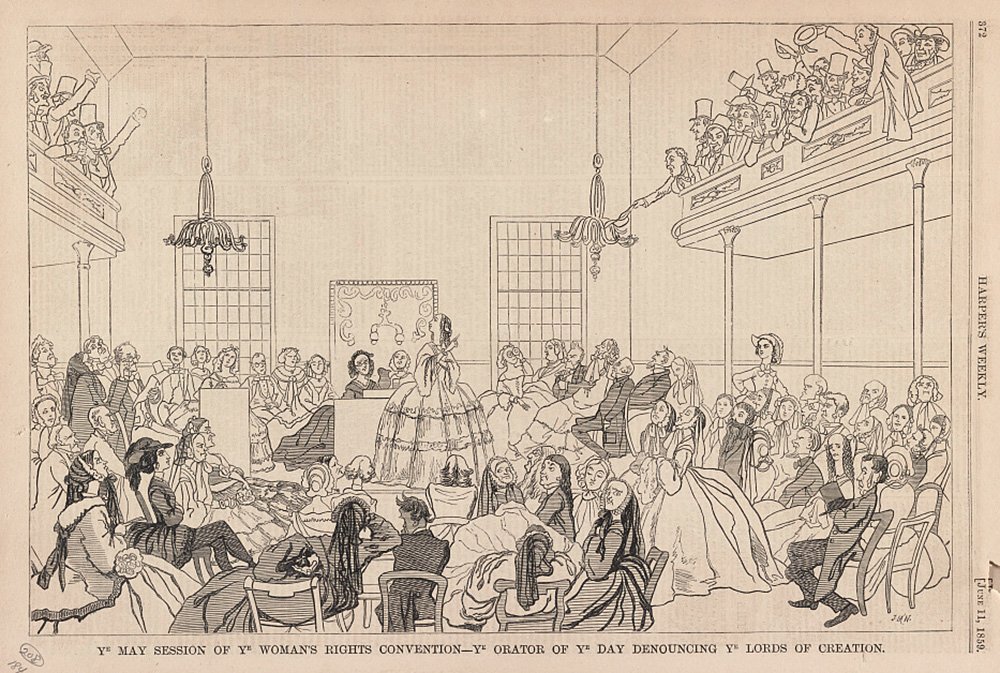
The nearly wholesale abandonment of the practice of head covering today in many Western cultures is only a relatively recent development. To make this point to your own satisfaction, look at photos and paintings and descriptions of life before (examples here) and after the time when the women's suffrage/women's liberation/feminism movement really gained traction. See the impact this radical movement has had on the expression of headship and the practice of head covering.
One milestone along the way involves a Declaration of Sentiments, drafted by Elizabeth Cady Stanton in 1848. It was modeled on the Declaration of Independence that was signed on July 4, 1776. Quoting an article on History.com called "Woman's Suffrage":
In 1848, a group of abolitionist activists —mostly women, but some men— gathered in Seneca Falls, New York to discuss the problem of women’s rights. ... "We hold these truths to be self-evident," proclaimed the Declaration of Sentiments that the delegates produced, "that all men and women are created equal, that they are endowed by their creator with certain inalienable rights, that among these are life, liberty, and the pursuit of happiness."
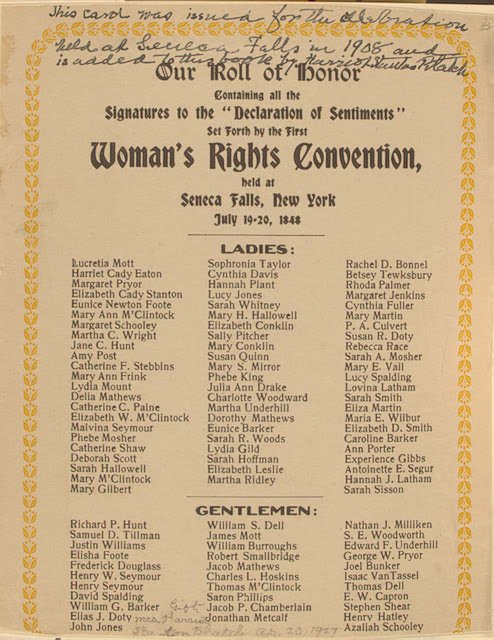
The delegates added the words, "and women" to explicitly include their gender. If you confuse patriotism with godliness, this will seem like a fair and reasonable thing. However, the Bible tells us about creation and even informs us about gender roles. The woman was made to be a helpmate and the man is the head of a woman. Regarding the false premise made by both declarations, all men are not created equal, and neither are all women. There are always going to be distinctions made with respect to racial heritage (Isaac and Ishmael, Jacob and Esau, Leah and Rachel...), and God makes some vessels for honor and some for dishonor as it pleases Him. He is the potter and we are the clay. The Declaration of Sentiments produced in 1848 is an expression of rebellion against the Creator, as was the Declaration of Independence before it. I could go on at length about that, but suffice it to say that what Paul wrote in Romans 13 bears the fingerprints of its Author just like in 1 Corinthians 11!
From the history.com page, Seneca Falls Convention:
Elizabeth Cady Stanton, one of the meeting’s organizers, began with a speech on the convention’s goals and purpose: "We are assembled to protest against a form of government, existing without the consent of the governed—to declare our right to be free as man is free, to be represented in the government which we are taxed to support, to have such disgraceful laws as give man the power to chastise and imprison his wife, to take the wages which she earns, the property which she inherits, and, in case of separation, the children of her love."
Several years ago, I visited Skaneateles, near Seneca Falls and the Wesleyan Chapel where what was heralded as the first women's rights convention was held. I found a small historical museum where, among the items on display, were several framed articles from newspapers about the movement's activity. The prominent people were identified along with descriptions of the roles they played. I was a little surprised to discover that some of the Quaker ministers from the area were very supportive and instrumental in bringing the feminist influence into the church. I later learned something else about the region that made a lot of sense to me, having grown up around there. The Iroquois were a matriarchal society. That explains a lot about the area, which includes Rochester, NY, about which I've written on The Open Scroll Blog.
It's worth noting here that this familiar version of our history has been credibly challenged, highlighting the self-serving wrangling of control by those we have been led to recognize as the movement's leaders. The actual history has been twisted and leveraged to significantly advance the agendas of the anti-patriarchal. The Myth of Seneca Falls: Memory and the Women’s Suffrage Movement: 1848-1898, by Lisa Tetrault, 2014. (winner of the 2015 Mary Jurich Nickliss Prize, Organization of American Historians)
With this brief consideration, can you see the impact of feminism's aggressive assault on the divinely established patriarchy and on the practices outlined in 1 Corinthians 14:34-38, 1 Timothy 2:9-15, and Ephesians 5:22-24? Of course, this is just me doing some "mansplaining" :( but please, make an effort to explore those scriptures with diligence and, as you take a sober look around, consider just how far we've fallen into apostasy.
Some Closing Observations
The practice of head covering is fundamentally very simple. During prayer and prophesying, what is proper for the man is that his head must not be covered. In contrast, a woman's head must be covered. There is no distinction made with regard to anyone's cultural heritage, to the formality of the occasion, as to whether one is indoors or out, or in a public or private setting. Any contention about the matter was to be settled with this argument, that neither those with Paul nor any of the churches of God had any variant practice. If you have neglected this in your life, perhaps what you've read here will inspire you to embrace the responsibility of modeling the truth of God's order to all creation, and to enter into greater blessing, power, and freedom in Christ!
According to 1 Thessalonians 5:17-18, we're instructed to pray without ceasing and to give thanks in all circumstances. To the degree that a woman does so, she should cover her head. To the degree that a man does so, he should have his head uncovered.
Perhaps you have found yourself reflecting on how the Lord has blessed you abundantly in your life despite the fact that you've never given head covering any consideration whatsoever. I don't question whether that might be so because I can relate! There have been times in my life when the Lord expected more from me, and perhaps such time has arrived for you. We can walk as children in ignorance for a season but when the Lord gives us more light we must rise up and walk in it. He is so good to us, showing tremendous mercy and grace with incredible patience! Whenever we might be blessed to receive some insight into the Lord's ways, His deeds, or His commands, it is truly a special blessing! Yet, whether or not we grasp the reasoning behind the Lord's commands, we are simply blessed if we obey them.
What if a woman is washing her hair, or otherwise unable to cover her head? Should she refrain from praying? That's between a woman and her head. Ladies, be honest about what times might be merely inconvenient or awkward. A man (more typically) might be required to wear something on his head because of his occupation or activity. A hardhat or helmet may be mandated for safety, for example. Should he refrain from praying when his head is covered in those situations? Again, that's between a man and his head. Practice being attentive to when you're praying and not, and when your covered and not. It does matter.
It may well be said that head covering is an example of virtue signaling. There are two perspectives between which you should carefully discern.
Today, this expression is taken to mean, "the act or practice of conspicuously displaying one's awareness of and attentiveness to political issues, matters of social and racial justice, etc., especially instead of taking effective action." It's a behavior associated with the Woke. You should be aware that there are women who will cover their heads in public (and, likewise, men who will uncover their heads) to signal that which isn't truly in their hearts. It's intended to deceive. Jezebel masquerades as Sarah. While this act doesn't fool the Lord or the angels, it can certainly fool people as a kind of virtue signaling. It's a tool for manipulating both men and women who naively assume that the head is always being covered (or uncovered) for the right reasons. Saints, be watchful.
There's another side to this virtue signaling, which is very much the point of head covering! Men and women signal their virtue in the things they do and say, in their manner of life, and especially when it comes to the practice of head covering because it's an expression of the glory language that does a wideband broadcast to all who bear witness! It's the kind of virtue signaling that is cause for celebration!
Now, on a very practical note, for those of you in the business of cutting women's hair in the fashions of the day, you have a responsibility to take these things into account where you might otherwise give no thought to the potential consequences.
When you consider all the issues raised by the blurring of genders today, of gender-swapping via transgendering or cross-dressing, the embracing of gender-fluidity and non-binary identification and the honoring of demands to respect an individual's preferred pronouns, there's all kinds of problems associated with this. The outcome of mental and emotional instability and suicidal tendencies for those most victimized was inevitable.

How did our culture come to so widely embrace and flaunt such abominations that are an offense to the Creator, even within what so many perceive as "the church"? It starts with small things. Imagine filling a glass with water dripping from a tap. Then, a bucket, a barrel, a pond and a raging river pours out and fills the ocean! It starts with small things, like how some view head covering, or women speaking in church, or women teaching men. Eventually the foundations flip over - and this is where we've arrived! Some say, take care of the little things and the big things will take care of themselves. That makes sense to me. Will we turn back the tide with our efforts and examples? The Lord will "fix this", in His time, with a small people who are submitted to Him. This, I know.
Appendix: A Consideration of Divine Order and a History of Rebellion
By choosing to obey the Lord's commands regarding head covering, we make a statement that is witnessed by those who occupy and function in the unseen realm. This bold testimony influences both the heavenly host and the host of heaven, which is to say, those who are for us and those who are against us. When we engage in spiritual warfare, we operate in a realm where relative authority matters.
Most of us know that there is power in the name of Jesus Christ of Nazareth, the risen son of God, and in his shed blood. We also know that we can't just wave these things around like a magic wand. Placing our trust in the symbolic cross like a magic amulet or talisman won't do, and neither will a reliance on water supposedly blessed by a priest. Where we put our faith matters. There's no bluffing and this is not a game.
When we obediently practice head covering, we make a show of humility and honor our heads. We signal our acceptance of our assigned roles as men and women. Through humility we access power. This is the Creator's way, Jesus' way. With a consideration of divine order and a reflection on the history of rebellion, we can gain some insight into what influence we have and what impact is made.
There has been more than one rebellion against the Creator. Rebellion results when there is a dissatisfaction with one's assigned rank. As I understand history, the first rebellion was led by an archangel who is typically referred to as Lucifer.
This "covering cherub" exalted himself and was subsequently humbled. The covering woman humbles herself and is thereby exalted!
There was another rebellion in the Garden of Eden, which resulted in curses being brought upon the Nachash, Eve and Adam.
Eve was baited with the temptation of becoming like God, enticing her to disobey, to rebel through the seeking of an elevated status. For her part, consider the consequences.
"To the woman He said, '...Yet your desire will be for your husband, And he will rule over you.'" Although she was made to be his helpmate, the consequence of her sin, in part, appears to have made her subject to her husband on some other level. This follows the example of the Nachash(serpent/anointed cherub who covers), where self-exaltation and rebellion leads to a humbling.
Now, with an understanding of the practice of head covering as an expression of divine order, you should be able to see how the obedient man and woman make a statement that confronts the fallen angels and all those who follow the way of Cain. This is a big deal!
When praying or prophesying, in the presence of the Most High, instead of exalting themselves with flesh boasting in His presence, the obedient man and woman make an open show of their acceptance of their humble estate, expressing contentment as they honor their head, Christ, and His head, the Most High. With virtue, they confront the fallen with this demonstration, this stark declaration, reminding them of the judgment that awaits them for their own failure to abide with humility, contentment and gratitude in the roles assigned to them by the Creator!
 Video
Video Audio Download
Audio Download